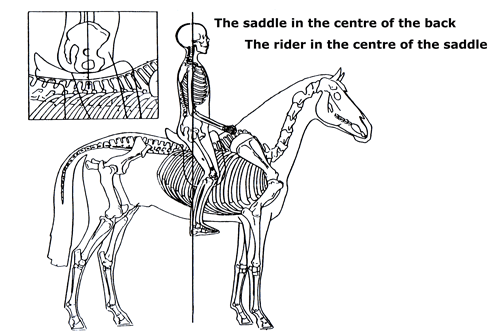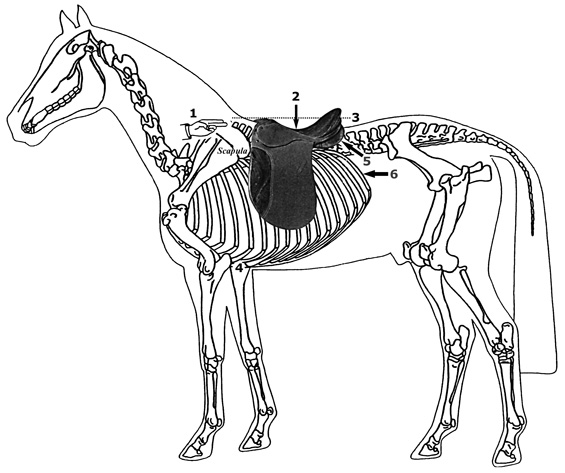1. It is the most important aspect of saddle fitting that the front arch of the tree is precisely the same shape and width as that part of the back upon which it should sit, i.e. approximately 3-4” behind the back top edge of the scapula or shoulder blade. The commonly held belief that there should be a three fingers gap between the underside of the front arch of the tree and the wither is misleading since with a thoroughbred, or any other high withered type, about two fingers will be adequate. Any more will cause the saddle to sit too low at the cantle end, whereas with a cob that has no withers, a five fingers gap could be appropriate.
2. The second most important rule is that the deepest part of the seat should be in the centre of the seat so that the rider is forced to sit in the centre of the seat of the saddle. This will mean that the combined weight of the saddle and the rider will be evenly distributed over the whole of the area of the panel from front to back and so avoiding unequal pressure. In this position both saddle and rider will be in balance and the legs will be in the correct position.
3. It is vitally imperative that no part of the panel is allowed to impinge on either shoulder blade or the vertebrae. Therefore the gullet or channel should be sufficiently wide to prevent this happening (not less than three fingers wide). With the saddle in balance the front of the panel will not make contact with the scapula other than very forward cut jumping saddles. Since show jumpers are in the habit of placing their saddles well forward, the front of the panel will of necessity be on top of the shoulder blade. However, since the practice is to use a saddle cloth plus a sheepskin saddle pad the friction between scapula and panel will be cushioned.
4. Since horses roamed the earth for thousands of years before man decided to ride them it is obvious that horses were NOT born with a girth groove, which is nominally located directly behind the elbow. I appreciate that it appears as if the horse was designed with a groove specially located to accept a girth but obviously this was not the case. Therefore “girth groove” must be a misnomer. The correct position for a girth is vertically beneath the saddle, i.e. where it hangs. It should certainly be no less than 5” behind the elbow if discomfort is to be avoided. To loop the girth forward to lay in the so-called “girth groove” will have the effect of pulling the saddle forward.
5. Ideally all panels should be flocked with pure white lambswool and in such a way as to conform to the curvature of the back. Some horses are “sway or dipped” in the back, particularly older ones. Other horses are flat backed, i.e. young ones. Therefore the panel should neither bridge (where it bears either end but not in the middle) nor rock (where the panel is too rounded). In other words it should bear evenly on the back all over in order to avoid pressure points. Of course all saddles must be ridden in so that the panel takes up the shape of the individual horse’s back and in this regard lambswool, being much softer than synthetic flock, will bed in much quicker and better than synthetic and for this reason a saddle should be kept for use on one specific horse only.
6. Ideally the rear of the panel should not extend beyond the last rib, but you will see from the diagram that this is not always possible if the saddle is positioned behind the scapula, which is of course imperative. However providing a saddle that is obviously too big for the horse is not fitted, this must be accepted. We do not consider that an inch or two beyond the last rib will cause any significant problems and is certainly preferable to putting the saddle more forward so that it restricts the free movement of the scapula.
These are the basic rules of fitting a saddle correctly and IN BALANCE (please refer to numbers on the skeletal diagram). Our definition of balance is to position the saddle on the back in such a way that the rider is forced to sit in the centre of the seat of the saddle so that the combined weight of the saddle and rider is evenly distributed over the whole bearing surface so that no pressure points are created. The rider’s legs will also be in the correct position, whereas a saddle position too far forward will cause the rider to sit on the back of the seat, concentrating weight on the back of the panel and placing the rider out of balance. It is remarkable how many saddles are positioned in this way, resulting in bad performance by both horse and rider, plus discomfort and a sore back for the horse.
Hopefully the foregoing will assist the reader to avoid using a saddle that is both poorly fitted and positioned. If in doubt, have the saddle checked by an experienced, qualified saddle fitter. If nothing else, you will avoid the costs of either a vet or the back person, plus discomfort for your horse. A horse will never be a willing partner while suffering discomfort caused by a poorly fitting saddle.


